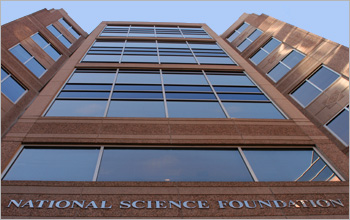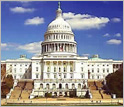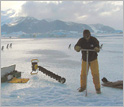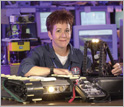 |
||||
|
|
||||
|
The National Science Foundation (NSF) is an independent federal agency created by Congress in 1950 "to promote the progress of science; to advance the national health, prosperity, and welfare; to secure the national defense…" With an annual budget of about $6.06 billion, we are the funding source for approximately 20 percent of all federally supported basic research conducted by America’s colleges and universities. In many fields such as mathematics, computer science and the social sciences, NSF is the major source of federal backing. We fulfill our mission chiefly by issuing limited-term grants -- currently about 10,000 new awards per year, with an average duration of three years -- to fund specific research proposals that have been judged the most promising by a rigorous and objective merit-review system. Most of these awards go to individuals or small groups of investigators. Others provide funding for research centers, instruments and facilities that allow scientists, engineers and students to work at the outermost frontiers of knowledge. NSF's goals--discovery, learning, research infrastructure and stewardship--provide an integrated strategy to advance the frontiers of knowledge, cultivate a world-class, broadly inclusive science and engineering workforce and expand the scientific literacy of all citizens, build the nation's research capability through investments in advanced instrumentation and facilities, and support excellence in science and engineering research and education through a capable and responsive organization. We like to say that NSF is "where discoveries begin." Many of the discoveries and technological advances have been truly revolutionary. In the past few decades, NSF-funded researchers have won more than 170 Nobel Prizes as well as other honors too numerous to list. These pioneers have included the scientists or teams that discovered many of the fundamental particles of matter, analyzed the cosmic microwaves left over from the earliest epoch of the universe, developed carbon-14 dating of ancient artifacts, decoded the genetics of viruses, and created an entirely new state of matter called a Bose-Einstein condensate. NSF also funds equipment that is needed by scientists and engineers but is often too expensive for any one group or researcher to afford. Examples of such major research equipment include giant optical and radio telescopes, Antarctic research sites, high-end computer facilities and ultra-high-speed connections, ships for ocean research, sensitive detectors of very subtle physical phenomena and gravitational wave observatories. Another essential element in NSF's mission is support for science and engineering education, from pre-K through graduate school and beyond. The research we fund is thoroughly integrated with education to help ensure that there will always be plenty of skilled people available to work in new and emerging scientific, engineering and technological fields, and plenty of capable teachers to educate the next generation. No single factor is more important to the intellectual and economic progress of society, and to the enhanced well-being of its citizens, than the continuous acquisition of new knowledge. NSF is proud to be a major part of that process. Specifically, the Foundation's organic legislation authorizes us to engage in the following activities: A. Initiate and support, through grants and contracts, scientific and engineering research and programs to strengthen scientific and engineering research potential, and education programs at all levels, and appraise the impact of research upon industrial development and the general welfare. B. Award graduate fellowships in the sciences and in engineering. C. Foster the interchange of scientific information among scientists and engineers in the United States and foreign countries. D. Foster and support the development and use of computers and other scientific methods and technologies, primarily for research and education in the sciences. E. Evaluate the status and needs of the various sciences and engineering and take into consideration the results of this evaluation in correlating our research and educational programs with other federal and non-federal programs. F. Provide a central clearinghouse for the collection, interpretation and analysis of data on scientific and technical resources in the United States, and provide a source of information for policy formulation by other federal agencies. G. Determine the total amount of federal money received by universities and appropriate organizations for the conduct of scientific and engineering research, including both basic and applied, and construction of facilities where such research is conducted, but excluding development, and report annually thereon to the President and the Congress. H. Initiate and support specific scientific and engineering activities in connection with matters relating to international cooperation, national security and the effects of scientific and technological applications upon society. I. Initiate and support scientific and engineering research, including applied research, at academic and other nonprofit institutions and, at the direction of the President, support applied research at other organizations. J. Recommend and encourage the pursuit of national policies for the promotion of basic research and education in the sciences and engineering. Strengthen research and education innovation in the sciences and engineering, including independent research by individuals, throughout the United States. K. Support activities designed to increase the participation of women and minorities and others underrepresented in science and technology. |
|
||||||||
| Web Policies and Important Links | | | Privacy | | | FOIA | | | Help | | | Contact NSF | | | Contact Webmaster | | | SiteMap |
|
The National Science Foundation, 4201 Wilson Boulevard, Arlington, Virginia 22230, USA Tel: (703) 292-5111 , FIRS: (800) 877-8339 | TDD: (800) 281-8749 |
|
|
Last Updated: Jul 10, 2008 |
|||





